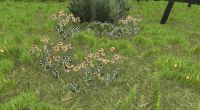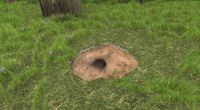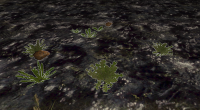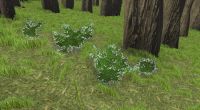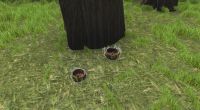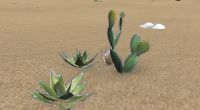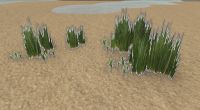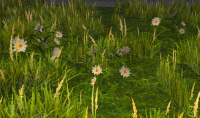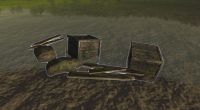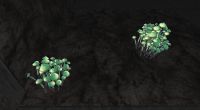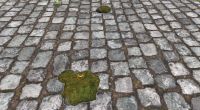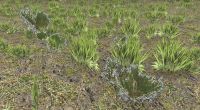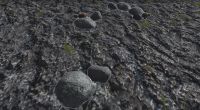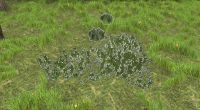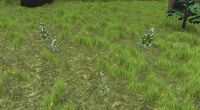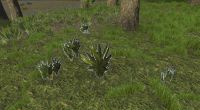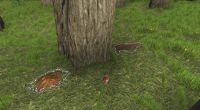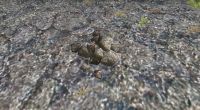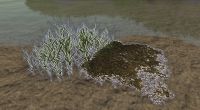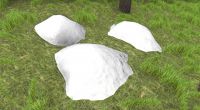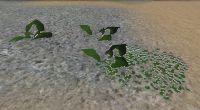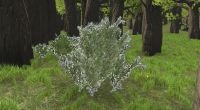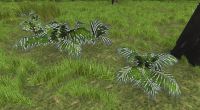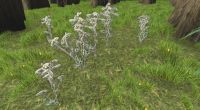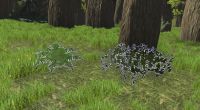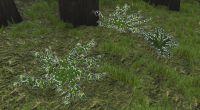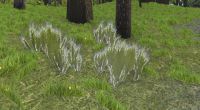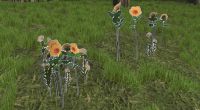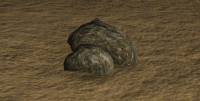Resource nodes
Contents
Description
The previous foraging, botanizing, and snow-collecting systems have been replaced by a new system where visible resource nodes spawn on tiles from which you can gather resources. Each type of resource node has its own appearance, set of possible items, and skill associated with it, and can be spotted visually while exploring the wilderness. All items previously available through foraging and botanizing are still available in the new system, along with many others, such as clay, ore/mineral shards, and a wider variety of plant products. Unlike the previous foraging and botanizing system, resource nodes are available on virtually every type of tile, including some exclusive to shallow water. Several tile types also have their own exclusive types of resource nodes that cannot appear anywhere else.
Node Spawning Conditions
- Resource nodes spawn above and below ground, and disappear randomly over time or when items are collected from them. Only one node can exist on a tile at any given time. A resource node will also be removed if the type of the tile changes, such as grass being packed with a shovel.
- The possibility, and probability, of a type of resource node spawning on a tile depends on factors including, but not limited to, tile type, altitude, season, and proximity to water. Similarly, the possibility and probability of getting specific items from a resource node can also depend on a variety of conditions. Some plants are more common in certain seasons, for example, and some very uncommon items might only be possible at high skill. All tile types can spawn at least one type of resource node.
- Note: “Snow pile” resource nodes, the new source of snowballs, can now be found outside Winter at sufficient altitude. This “snow line” changes elevation throughout the in-game year, so some areas may get snow year-round, while others may only experience it closer to Winter. All snow piles, however, will provide more snowballs in Winter than in other seasons.
- Nodes cannot spawn inside buildings but they can spawn on deed. A new settlement management setting has been introduced to prevent resource nodes from appearing within your village.
Modifiers Various conditions can modify how likely a resource node is to spawn, how likely an item is to be chosen when gathering from one, and how many items you can gather from one resource node. All current modifiers are taken into account when “Lore” is used on tiles and resource nodes. These modifiers include, but are not limited to:
Season (most plant-based resource nodes and items are more common in some seasons than others, and less common in winter, but there are exceptions) Altitude Slope (most resource nodes are less common on steeper slopes) Above or below ground Tile type Above or below water Above or below the snow line Grass length Mycelium-infected, enchanted, or neither Your current skill level (especially for less common items and items with a minimum skill level) Your current wounds (as in the old system, being injured makes you more likely to find items that can bandage wounds) Tree/Bush age Existence of a bridge over the tile
Collecting resources from the Nodes
- Right clicking a resource node will allow you to examine it for a general description, and gather resources from it (“Forage”, “Botanize”, or “Collect” depending on the type).
- Using “Lore” on a resource node will tell you what kinds of items you could collect from it, in order of how likely they are, as well as how difficult the action will be compared to your skill level, and the number of items you will receive. Which items you find from a specific type of resource node, and how likely they are, can depend on similar factors. For example, as in the current system, woad is more common on steppe, but this also extends to certain plants being more common in certain seasons, near water, or several other factors.
- Using “Lore” on a tile will tell you what resource nodes might spawn there, also in order of likelihood.
- Quality of gathered items is directly related to skill, but the difficulty of foraging or botanizing is determined by the type of resource node, the type of tile, and the specific item gathered from it. Some special items may also require a certain amount of skill to gather at all, or may become more likely at higher skill.
- The number of items you can collect from a Foraging or Botanizing resource node depends on the type of resource node, some other factors (such as tile type or grass length), and your skill level. Unlike in the previous system, higher skill level simply adds a flat value to the number of items you will receive:
20-50 skill: +1 50-70 skill: +2 70-90 skill: +3 90+ skill: +4
Magical enchantments on equipped gloves can now be used when collecting from resource nodes, as well as when creating or improving clay items with the hand:
Only magical effects such as runes and spell enchantments function for this purpose. For example, Wind of Ages will improve action speed and Circle of Cunning will improve skill gain. The glove is not being used as an actual tool, so it will not receive damage, and its quality, rarity, and material will have no impact on effectiveness. However, like a tool, enchantments will still decay from use. Enchantment/Rune effectiveness is averaged between both gloves. For example, having 100 Wind of Ages on one glove and 50 on the other will be equivalent to having 75 Wind of Ages on a tool, and having a rune on one glove but not the other will result in that rune being half as effective as usual.
Resource types
There are currently 29 known types of resource nodes.
| Node | Location | Action | Possible Resources | Image |
|---|---|---|---|---|
| Alpine brush | High Altitudes | Botanize |
Onions, sassafras, lingonberries, potatoes, cabbages, carrots, sugar beets, green apples, low quality cotton, green tea leaves, and honey nuts. |
|
| Animal burrow | Everywhere (except Lava) | Forage |
Nuts, berries, crop seeds, carrots, potatoes, cabbages, low quality wool, low quality cotton, grubs, and very low quality gems. |
|
| Bog muck | Tar / Peat | Forage |
Tar, horns, hooves, blueberries, low quality iron rocks, goblin skulls, and lost footwear. |
|
| Briar patch | Woodland / Steppe / Peat / Tundra | Botanize |
Blueberries, handfuls of raspberries, rose flowers, branches, bush sprouts, and starberries. |
|
| Carrion | Mycelium | Forage |
Hooves, horns, low quality skins, low quality offal, teeth, low quality meat, low quality wool, twisted horns, goblin skulls and Ink sacs. |
|
| Critter nest | Woodland / Marsh | Forage |
Nuts, eggs, acorns, berries, feathers, crop seeds, low quality wool, low quality cotton, and low quality jewelry. |
|
| Desert weeds | Sandy area | Botanize |
Cumin, fennel plant, low quality sage, low quality oregano, low quality bunches of mixed grass, cotton, and golden pepper. |
|
| Dune grass | Sand | Botanize |
Rice, pea pods, fennel plant, low quality grains, reed plants, cotton, and bunches of mixed grass. |
|
| Fairy garden | Enchanted grass | Botanize |
Herbs, berries, fruits, spices, nuts, exceptional quality herbs, exceptional quality berries, exceptional quality fruits, exceptional quality spices, exceptional quality nuts, exceptional quality tropical fruits, and holy plants. |
|
| Flotsam | Water near Shore | Forage |
Low quality wood scrap, low quality square pieces of cloth, wemp fibre, low quality shafts, low quality logs, low quality ropes, spice jars, very low quality nails, low quality wooden ship parts, low quality sailing ropes, low quality liquor bottles, and liquor barrels. |
|
| Fungus | Underground | Forage | Brown mushrooms, green mushrooms, yellow mushrooms, black mushrooms, red mushrooms, and blue mushrooms. | |
| Lichen | Rock / paving / Dirt | Forage |
Moss, green mushrooms, low quality stone shards, and very low quality iron rocks. |
|
| Low brush | Steppe | Botanize |
Woad, strawberries, wemp plants, cotton, thyme, basil, nutmeg, cacao beans, and coffee cherries. |
|
| Mineral debris | Everywhere (except Lava) including Lawn | Forage |
Low quality stone shards, very low quality clay, very low quality iron rocks, low quality salt, and low quality gold and silver lumps. |
|
| Mints | Woodland / Moss / Marsh / Peat | Botanize |
Mint, rosemary, sage, thyme, oregano, basil, and lavender flowers. |
|
| Nightshades | Woodland / Steppe / Marsh / Peat / Moss | Botanize |
Bouquets of purple flowers, potatoes, belladonna, tomatoes, paprika, and worgsbane. |
|
| Roots and bulbs | Woodland / Steppe / Tundra / | Botanize |
Onions, garlic, potatoes, carrots, ginger, turmeric, and sugar beets. |
|
| Rotting wood | Woodland / Moss / Marsh / Peat / Tundra | Forage |
Nettles, brown mushrooms, red mushrooms, blue mushrooms, low quality branches, low quality tree sprouts, low quality seedlings, moss, and very low quality logs. |
|
| Rubble | Rock / Gravel / Underground / Lava | Forage | Stone shards, sandstone shards, slate shards, vlq iron rocks, marble shards, lq ore, lq flints, lq gems, lq rock salts, and ash. | |
| Seaweed | Shoreline / Shallow waters | Forage |
Rice, reed plants, bunches of kelp, low quality small freshwater fish, fishing hooks, clams, and pearls. |
|
| Snow pile | Everywhere in Winter / Higher Alts in other seasons | Collect | Snowballs | |
| Swampy puddle | Clay / Moss / Marsh / Peat | Botanize |
Brown mushrooms, red mushrooms, reed plants, low quality rice, mint, low quality handfuls of raspberries, moss, and low quality blueberries. |
|
| Thicket | Woodland | Botanize |
Bush sprouts, fruit tree sprouts, berries, sassafras, hazelnuts, grapes, green apples, olives, red cherries, cotton, pineapples, and coconuts. |
|
| Tropical foliage | Grassland / Woodland at Lower alts | Botanize | Paprika, turmeric, nutmeg, coffee cherries, cacao beans, green tea leaves, pineapples, and coconuts. | |
| Umbellifers | Grassland / Woodland / Tundra / Marsh / Moss | Botanize |
Carrots, parsley, fennel plant, lovage, and cumin. |
|
| Undergrowth | Woodland | Forage |
Branches, nettles, sprouts, acorns, nuts, low quality logs, wemp plants, and cotton. |
|
| Vines | Woodland / Steppe / Marsh | Botanize |
Grapes, pea pods, cucumbers, pumpkins, tomatoes, seedlings, hops, and drakemelons. |
|
| Wild grasses | Woodland / Steppe / Shoreline | Botanize |
Barley, wheat, oats, rye, bunches of mixed grass, reed plants, corn, rice, and source seeds. |
|
| Wildflowers | Grassland / Woodland / Steppe | Botanize |
Bouquets of common flowers, lavender flowers, camellia flowers, parsley, oleander, rosemary, lovage, belladonna, woad, rose flowers, and bouquets of dotted flowers. |
|
| Monster camp | Everywhere | Forage | Meat, wool, furs, low quality strips of leather, teeth, ash, low quality charcoal, low quality planks, low quality nails, exceptional quality common monster cuisine, very low quality human clothing, exceptional quality rare monster cuisine, exceptional quality supreme monster cuisine, low quality human jewelry, and exceptional quality fantastic monster cuisine. |
Notes
- Using “Lore” on tiles and resource nodes may not show some resource node types or items until you meet a minimum skill requirement. For tiles, this requirement is the base difficulty of the resource node type, plus 15. For items, this requirement is the minimum skill required to gather the item, minus 15. The Lore command will tell you if your low skill is preventing you from seeing anything.
- Resource nodes spawn and disappear randomly over time. It can be a few days or more for new resource nodes to appear on an empty tile.
